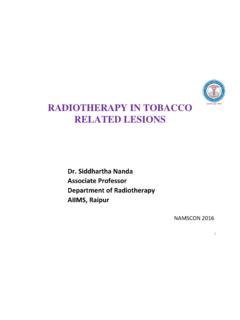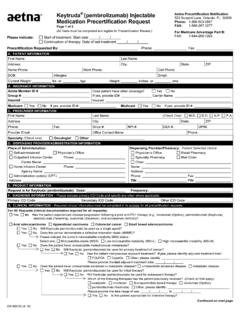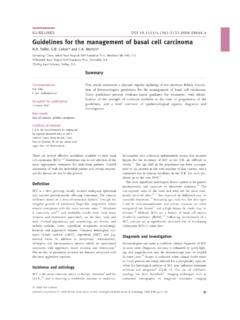Transcription of Section 4 Oral mucositis guidelines - Welcome to …
1 Section 4. oral mucositis guidelines guidelines Implementation Toolkit Contents Section 4 oral mucositis guidelines Introduction to Section 4. Introduction Overall Goal Specific Targets and Aims The Nurse's Role Key points to understand from the oral mucositis guidelines What is oral mucositis ? oral mucositis -related symptoms Grades of oral mucositis What are the implications of oral mucositis for the patient? Consequences of oral mucositis Impact on chemotherapy dose and cancer outcomes Quality of life issues Hospitalisation and related issues How is oral mucositis recognised? Relative risk of developing oral mucositis Recognising signs of infection How is oral mucositis managed? Radiotherapy prevention Standard-dose chemotherapy prevention High-dose chemotherapy with or without total-body irradiation plus haematopoietic stem cell transplantation prevention Patient education oral care Standard-dose chemotherapy treatment Cycles of treatment Scoring, re-evaluation and monitoring How is pain managed in patients with oral mucositis ?
2 Pain assessment Standardise analgesia treatment Appendix Abbreviations References 2. Introduction oral mucositis (OM) can be a significant problem for cancer patients, developing as a common side effect of both chemotherapy and radiotherapy. In fact, nearly all patients receiving high-dose chemotherapy with haematopoietic stem cell transplantation (HCST) are OM causes pain and other symptoms that affect quality of life. In addition, OM may become a barrier to successful administration of chemotherapy and/or Section 4 introduces the topic of OM and covers the clinical practice guidelines for the prevention and treatment of cancer therapy-induced OM developed by the Multinational Association of Supportive Care in cancer and the International Society of oral Oncology (MASCC/ISOO).1,2 These guidelines (written in 2004 and updated in 2005) give recommendations on effective strategies for the prevention and treatment of OM in the setting of radiation therapy, chemotherapy and combined chemoradiation therapy, and also highlight strategies to be avoided in clinical practice.
3 Overall Goal Specific Targets and Aims The Nurse's Role Overall Goal The overall goal of these guidelines is to incorporate the latest developments in OM into standardised patient care. Specific Targets and Aims The targets and aims of this module are to: Address the differences in mucositis scoring used by clinicians and researchers Explain how variations in clinical trial design and implementation have prevented treatment recommendations from being made Describe the evolution of patient care (from a variety of clinical practices like oral oncology, radiation oncology, medical oncology and haematology). Explain how current OM assessment and management has evolved from clinical experience rather then clinical evidence Discuss the evidence to support appropriate OM management A thorough understanding of the issues in this Section should enable: Better application of evidence, where it exists, for the prevention and management of patients with OM.
4 An understanding of the need for appropriate and consistent assessment and scoring of OM. An understanding, based on current data, of which patients are at high-risk of developing OM. An understanding of when and where to implement OM guidelines 3. Table of contents The Nurse's Role Nurses are among the best placed professionals to assess patients for risk by reviewing their patients'. history and current health status. Oncology nurses are in a unique position to recognise, assess and treat the symptoms of OM through their frequent contact with the patients allowing them to assess risk and intervene with preventive strategies. There are three key areas where the nurse can make an impact in OM management:3. 1. Effective assessment and monitoring of the oral cavity and symptoms 2. Disease management and focusing on ensuring appropriate interventions 3. Patient education These guidelines will highlight the role that nurses play in identifying and managing OM and highlight risk factors associated with it.
5 Nursing care protocols for OM management may allow more patients to receive chemotherapies on schedule and at full-dose, as well as reducing potential practice variations that could compromise care, promote cost-effectiveness and increase the quality of care for Furthermore, nursing care protocols may help to improve patient quality of life, which is typically affected in OM 4. Table of contents What is oral mucositis ? oral mucositis (OM) is the inflammation of the mucosal membranes that line the inner surfaces of the mouth. The cells of these linings usually turn over at a rapid rate, which makes them prone to the effects of cancer chemotherapy and The first stage of OM is characterised by injury of the submucosal cells in the mouth. This injury sets off a cascade of events eventually leading to more extensive damage to underlying cells and If OM goes unchecked, cell damage and death can outweigh the cell healing and renewal, thereby shifting the balance towards cell loss.
6 At this point, damage to the mucosa can progress into a more severe ulcerative stage, where the mucosal barrier is broken down. Once it develops, this can put the patient at increased risk for infections of the mouth. 2. oral mucositis -related symptoms Grades of oral mucositis oral mucositis -related symptoms The inflammation in OM can range from redness, or erythema, to severe ulceration, and is typically associated with pain and The pain and discomfort can be so severe that it leads to difficulties in eating, drinking, swallowing and speaking extending to an inability to tolerate solid food and liquids, and resulting in impaired nutritional status and inadequate Clinical signs of mucosal damage and cell death may appear after the first 1 2 weeks following radiation therapy, and as early as 3 days after chemotherapy. The resulting pain and dysfunction of OM can interfere with nutritional intake and result in:3.
7 Weight loss Anorexia Malnutrition Dehydration Patients with damaged oral mucosa have an open portal of entry for organisms. In addition, reduced immunity resulting from chemotherapy and radiotherapy makes them prone to opportunistic infections in the mouth, such as:3,4. Fungal infections ( Candida albicans). Herpes infection OM may also affect the patient's dental health and gums ( cavities).3. 5. Table of contents Grades of oral mucositis The World Health Organisation (WHO) grades OM as follows:5. Grade 0 no changes Grade 1 soreness/erythema Grade 2 soreness/erythema + ulceration + can eat solid foods Grade 3 soreness/erythema + ulceration + can use a liquid diet only Grade 4 soreness/erythema + ulceration + oral alimentation is not possible 6. Table of contents What are the implications of oral mucositis for the patient? oral mucositis (OM) can be a significant problem for cancer patients (Figure 1).
8 Pain and discomfort can lead to the symptoms mentioned and can have effects on patient quality of life (QoL) and patient outcomes, and lead to increased healthcare costs ( hospitalisation, anti-infective treatment). Consequences of oral mucositis Impact on chemotherapy dose and cancer outcomes Quality of life issues Hospitalisation and related issues Consequences of oral mucositis Pain +/ infection Impaired nutritional status and hydration Parenteral nutrition Narcotics Antimicrobials Hospitalisation Dose-limiting toxicity Treatment interruptions Decreased outcomes (decreased tumour response and patient survival). Figure 1: Consequences of OM is associated with a high risk of systemic infections and haemorrhage,and can lead to reductions or delays in patients receiving radiotherapy or chemotherapy. OM compromises patient outcomes and leads to increased healthcare costs as a result of prolonged hospitalisation and the need for anti- infective 7.
9 Table of contents Impact on chemotherapy dose and cancer outcomes Because it is associated with pain, discomfort and a risk of systemic infection, OM is increasingly recognised as a dose-limiting toxicity in cancer If cancer therapy dose is decreased, it may limit its 12. As a result, OM may be associated an overall worsening of long-term treatment outcomes in 12 This has led physicians and oncologists to increase awareness of the risks of OM to the medical This, in turn, has led to the completion of these OM guidelines . Quality of life issues In addition to its local effects, OM has a profound effect on patient well-being and QoL, such as:2,3. Difficulty chewing and eating Loss of taste Difficulty drinking Difficulty swallowing Difficulty speaking Abdominal disturbances Increased depression Sleep disturbances Fatigue These effects further compromise the patients' response to treatment and/or palliative care.
10 In fact, OM is reported as the most debilitating symptom among transplant patients, as well as those undergoing radiotherapy for head and neck cancer . Hospitalisation and related issues Patients suffering from OM may require longer hospitalisation, high doses of analgesics, and intravenous feeding to receive nutrition and maintain ,14 Estimates show that OM can be associated with a mean increase of $35,000 in hospital charges per 8. Table of contents How is oral mucositis recognised? It is important to recognise oral mucositis (OM) early on, so as to avoid the negative consequences and any negative impact on cancer treatment. In order to do this, one must understand which patients are at the greatest risk and understand how to recognise the signs and symptoms. Relative risk of developing oral mucositis Recognising signs of infection Relative risk of developing oral mucositis There is a 40% relative risk of developing OM following many standard chemotherapy regimens; but there is a 100% relative risk following high-dose radiotherapy as treatment for head and neck ,3 Furthermore, nearly all patients receiving high-dose chemotherapy with haematopoietic stem cell transplantation (HCST) are A schematic of the relationship between different therapies and the risk of developing OM is shown in Figure 2.








